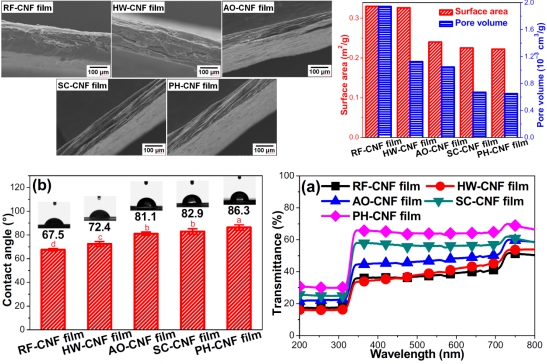Scientists from IBFC CAAS and HUNAU Discover a New Approach to the Modulation of Micro-nano Structure of Nanocellulose Films
Recently, researchers from Institute of Bast Fiber Crops, Chinese Academy of Agricultural Sciences (IBFC, CAAS) and Hunan Agricultural University (HUNAU) have systematically investigated the influence of pectin on the micro-nanostructure and physical properties of nanocellulose films and a new method based on pectin for regulating the micro-nano structure of nanocellulose films was constructed. This study provides new ideas for the multifunctional development and application of nanocellulose films, and also presents new technical routes in the field of biomass resource conversion and utilization.
Nanocellulose films consist of cellulose fibers with at least one dimension below 100 nm. Due to its abundance, biodegradability, biocompatibility, lightweight, excellent mechanical properties, and high structural/chemical tunability, nanocellulose and its films have a wide range of applications in automotive, aerospace, construction, electronics, cosmetics, coatings/paint, food packaging, paperboard/packaging, specialty paper, composites/polymer reinforcement, health care, oil drilling and other fields.
In this study, cellulose nanofibril (CNF) films from ramie fibers were prepared with different pectin compositions and contents, and the influence of residual pectin on the overall performances of CNF films was evaluated. There was no significant effect of the residual pectin composition on the properties of obtained CNF films. However, pectin covers the CNF surface and act as a physical barrier between the cellulose fibrils; thus the nanocellulose films with high pectin content will have a loose and porous structure, resulting in a high surface area and a high water absorption. After removal of amorphous pectins in CNFs, the low pectin containing CNFs is able to pack more compactly to form a strong and thin film. This paper provides guidance for the preparation of CNF films with different performance requirements.
The research was supported by the Youth Program of the National Natural Science Foundation of China, the Science and Technology Innovation Project of the CAAS, and so on.
The study entitled “The influence of residual pectin composition and content on nanocellulose films from ramie fibers: Micro-nano structure and physical properties” has been published online in International Journal of Biological Macromolecules and can be accessed through the following link:
https://doi.org/10.1016/j.ijbiomac.2023.125812.

Fig. Micro-nano structure and related physical properties of nanocellulose films with different pectin contents
-
 Apr 18, 2024Opening Ceremony of the Training Workshop on Wheat Head Scab Resistance Breeding and Pest Control in Africa Held in CAAS
Apr 18, 2024Opening Ceremony of the Training Workshop on Wheat Head Scab Resistance Breeding and Pest Control in Africa Held in CAAS -
 Apr 03, 2024IPPCAAS Co-organized the Training Workshop on Management and Application of Biopesticides in Nepal
Apr 03, 2024IPPCAAS Co-organized the Training Workshop on Management and Application of Biopesticides in Nepal -
 Mar 28, 2024Delegation from the School of Agriculture and Food Science of University College Dublin, Ireland Visit to IAS, CAAS
Mar 28, 2024Delegation from the School of Agriculture and Food Science of University College Dublin, Ireland Visit to IAS, CAAS -
 Mar 25, 2024Director of World Food Prize Foundation visited GSCAAS
Mar 25, 2024Director of World Food Prize Foundation visited GSCAAS -
 Mar 20, 2024Institute of Crop Sciences (ICS) and Syngenta Group Global Seeds Advance Collaborative Research in the Seed Industry
Mar 20, 2024Institute of Crop Sciences (ICS) and Syngenta Group Global Seeds Advance Collaborative Research in the Seed Industry
